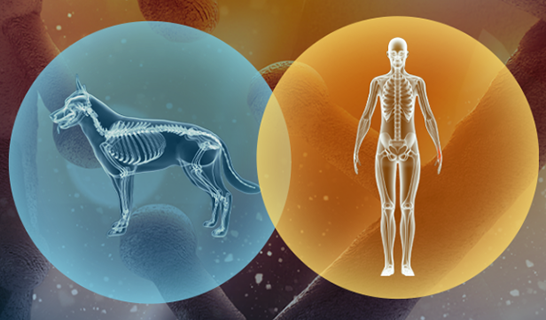Editor’s note: A version of this article originally appeared on the Frederick National Laboratory website.
Dogs and humans have been companions throughout recorded history. Our four-legged friends appear in early written tales, such as the Mesopotamian poem The Epic of Gilgamesh, and are mentioned by name in ancient Egyptian inscriptions. In prehistoric gravesites worldwide, dogs are found laid to rest alongside humans. They’ve been with us through thick and thin, and we have truly benefited from this.
Recently, that companionship entered a new arena, with dogs becoming humans’ partners in cancer research—and at Frederick National Laboratory for Cancer Research, scientists and engineers have built and deployed a tool to help the medical community maximize canines’ contributions to oncology.
It’s called the Integrated Canine Data Commons, a repository of data from pet dogs with cancer. Sponsored by the National Cancer Institute, its purpose is to help human and canine cancer patients.
“These are pet animals that are diagnosed with some type of cancer by a veterinarian, and they become enrolled in a clinical trial—sometimes with experimental therapies—for understanding and tracking their prognosis and for studying the genomics component to better understand abnormalities in genes that drive cancers,” said Gina Kuffel, the technical project manager for the canine data commons in the Bioinformatics and Computational Science Directorate at Frederick National Laboratory.
In living with us, dogs are exposed to many of the factors that may give us cancer. Their cancers are similar to ours. They’re suitable for genetic study and for treatment that might benefit them and human patients facing tumors driven by the same genetic abnormality. That’s why dogs are a valuable source of clinical information.
Clinical trials give canine cancer patients another chance at treatment, while scientists get a trove of data on how experimental treatments may or may not benefit human patients. In some cases, such as the bone cancer osteosarcoma, those data have led to clinical trials that have helped humans.
Housing the Data
Now in its fourth year, the canine data commons “is really beginning to hit its stride” as a home for canine data, said John Otridge, Ph.D., the director of the BACS Center for Technical Operations Support, one of the main groups handling the data commons.
It is publicly accessible and contains data currently spanning 10 studies and 634 cases of canine cancer. Its repertoire contains various types of genetic data, RNA sequences, and demographic data, among others. Having that findability, diversity, and volume in one place allows researchers to compare and analyze information in ways that would be challenging otherwise.
Unlike most repositories, which specialize in one or two kinds of data, “the breadth of data that we are going to be receiving is much wider,” Otridge said. “At the very beginning, we could see that this could be the crystal that grows for a canine community to coordinate around.”
‘On the Precipice’
And the metaphorical crystal is beginning to grow.
The canine data commons’ first few years were devoted to technical development, with the team constructing the repository, integrating data, and planning with a steering committee of experts from the National Cancer Institute and external organizations. Ralph Parchment and colleagues in Frederick National Laboratory’s Applied and Developmental Research Directorate joined the establishment effort and now help manage the data commons.
It was a humble start, but since going live, the canine data commons has come to house over 33 terabytes of data, more than can be stored on 60 average laptops—and Kuffel and Otridge say it’s just the beginning. The team continues to encourage and empower veterinary oncologists to upload their data.
Alongside those sorts of projects, the team releases new software updates quarterly, including features and tools that make the repository more useful and user-friendly for researchers’ analyses. Users can query, examine, and interact with data and files in a multitude of ways.
These efforts haven’t gone unrecognized. Last November, CBS News’ 60 Minutes covered the topic, and this year, members of the canine data commons team were chosen to deliver an oral presentation at the annual American College of Veterinary Internal Medicine conference in Philadelphia. The conversation is beginning to shift, thanks to progress in canine comparative cancer research and repositories like the canine data commons.
“Even back in 2018, canine wasn’t necessarily considered an acceptable [cancer] model for humans, and I think that’s rapidly changing,” Kuffel said. “We’re on the precipice of something very important and special, because people’s minds are changing, and this is happening because of research and data that’s been brought to light in the comparative analysis arena.”
It’s “something that’s truly helping both species,” she added.
Samuel Lopez leads the editorial team in Scientific Publications, Graphics & Media (SPGM). He writes for newsletters; informally serves as an institutional historian; and edits scientific manuscripts, corporate documents, and sundry other written media. SPGM is the creative services department and hub for editing, illustration, graphic design, formatting, multimedia, and training in these areas.
Teaser image on the blogroll is a modified version of an original photo by Dirk Vorderstraße, CC BY 2.0.


